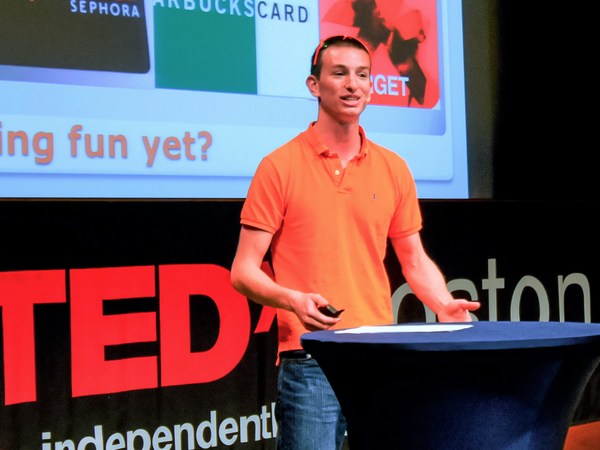The maxim, "Know thyself" has been around since the ancient Greeks. Some attribute this golden world knowledge to Plato, others to Pythagoras. But the truth is it doesn't really matter which sage said it first, because it's still sage advice, even today. "Know thyself." It's pithy almost to the point of being meaningless, but it rings familiar and true, doesn't it? "Know thyself." I understand this timeless dictum as a statement about the problems, or more exactly, the confusions, of consciousness. I've always been fascinated with knowing the self. This fascination led me to submerge myself in art, study neuroscience, and later, to become a psychotherapist.
Today I combine all my passions as the CEO of InteraXon, a thought-controlled computing company. My goal, quite simply, is to help people become more in tune with themselves. I take it from this little dictum, "Know thyself." If you think about it, this imperative is kind of the defining characteristic of our species, isn't it? I mean, it's self-awareness that separates Homo sapiens from earlier instances of our mankind.
Today we're often too busy tending to our iPhones and iPods to really stop and get to know ourselves. Under the deluge of minute-to-minute text conversations, e-mails, relentless exchange of media channels and passwords and apps and reminders and Tweets and tags, we lose sight of what all this fuss is supposed to be about in the first place: Ourselves. Much of the time we're transfixed by all of the ways we can reflect ourselves out into the world. And we can barely find the time to reflect deeply back in on our own selves. We've cluttered ourselves up with all this. And we feel like we have to get far, far away to a secluded retreat, leaving it all behind.
So we go far away to the top of a mountain, assuming that perching ourselves on a piece is bound to give us the respite we need to sort the clutter, the chaotic everyday, and find ourselves again. But on that mountain where we gain that beautiful peace of mind, what are we really achieving? It's really only a successful escape. Think of the term we use, "Retreat." This is the term that armies use when they've lost a battle. It means we've got to get out of here. Is this how we feel about the pressures of our world, that in order to get inside ourselves, you have to run for the hills? And the problem with escaping your day-to-day life is that you have to come home, eventually. So when you think about it, we're almost like a tourist visiting ourselves over there. And eventually, that vacation's got to come to an end.
So my question to you is, can we find ways to know ourselves without the escape? Can we redefine our relationship with the technologized world in order to have the heightened sense of self-awareness that we seek? Can we live here and now in our wired web and still follow those ancient instructions, "Know thyself?" I say the answer is yes. And I'm here today to share a new way that we're working with technology to this end, to get familiar with our inner self like never before -- humanizing technology and furthering that age-old quest of ours to more fully know the self. It's called thought-controlled computing.
You may or may not have noticed that I'm wearing a tiny electrode on my forehead. This is actually a brainwave sensor that's reading the electrical activity of my brain as I give this talk. These brainwaves are being analyzed and we can see them as a graph. Let me show you what it looks like. That blue line there is my brainwave. It's the direct signal being recorded from my head, rendered in real time. The green and red bars show that same signal displayed by frequency, with lower frequencies here and higher frequencies up here. You're actually looking inside my head as I speak. These graphs are compelling, they're undulating, but from a human's perspective, they're actually not very useful. That's why we've spent a lot of time thinking about how to make this data meaningful to the people who use it.
For instance, what if I could use this data to find out how relaxed I am at any moment? Or what if I can take that information and put it into an organic shape up on the screen? The shape on the right over here has become an indicator of what's going on in my head. The more relaxed I am, the more the energy's going to fall through it. I may also be interested in knowing how focused I am, so I can put my level of attention into the circuit board on the other side. And the more focused my brain is, the more the circuit board is going to surge with energy.
Ordinarily, I would have no way of knowing how focused or relaxed I was in any tangible way. As we know, our feelings about how we're feeling are notoriously unreliable. We've all had stress creep up on us without even noticing it until we lost it on someone who didn't deserve it, and then we realize that we probably should have checked in with ourselves a little earlier. This new awareness opens up vast possibilities for applications that help improve our lives and ourselves. We're trying to create technology that uses the insights to make our work more efficient, our breaks more relaxing and our connections deeper and more fulfilling than ever. I'm going to share some of these visions with you in a bit, but first I want to take a look at how we got here. By the way, feel free to check in on my head at any time.
(Laughter)
My team at InteraXon and I have been developing thought-controlled application for almost a decade now. In the first phase of development, we were really enthused by all the things we could control with our mind. We were making things activate, light up and work just by thinking. We were transcending the space between the mind and the device. We brought to life a vast array of prototypes and products that you could control with your mind, like thought-controlled home appliances or slot-car games or video games or a levitating chair. We created technology and applications that engaged people's imaginations, and it was really exciting.
And then we were asked to do something really big for the Olympics. We were invited to create a massive installation at the Vancouver 2010 winter Olympics, were used in Vancouver, got to control the lighting on the CN Tower, the Canadian Parliament buildings and Niagara Falls from all the way across the country using their minds. Over 17 days at the Olympics, 7,000 visitors from all over the world actually got to individually control the light from the CN Tower, parliament and Niagara in real time with their minds from across the country, 3,000 km away. So controlling stuff with your mind is pretty cool.
But we're always interested in multitiered levels of human interaction. And so we began looking into inventing thought-controlled applications in a more complex frame than just control. And that was responsiveness. We realized that we had a system that allowed technology to know something about you. And it could join into the relationship with you. We created the responsive room where the lights, music and blinds adjusted to your state. They followed these little shifts in your mental activity. So as you settled into relaxation at the end of a hard day, on the couch in our office, the music would mellow with you. When you read, the desk lamp would get brighter. If you nod off, the system would know, dimming to darkness as you do.
We then realized that if technology could know something about you and use it to help you, there's an even more valuable application than that. That you could know something about yourself. We could know sides of ourselves that were all but invisible and come to see things that were previously hidden. Let me show you an example of what I'm talking about here.
Here's an application that I created for the iPad. So the goal of the original game Zen Bound is to wrap a rope around a wooden form. So you use it with your headset. The headset connects wirelessly to an iPad or a smartphone. In that headset, you have fabric sensors on your forehead and above the ear. In the original Zen Bound game, you play it by scrolling your fingers over the pad. In the game that we created, of course, you control the wooden form that's on the screen there with your mind. As you focus on the wooden form, it rotates. The more you focus, the faster the rotation. This is for real. This is not a fake. What's really interesting to me though is at the end of the game, you get stats and feedback about how you did. You have graphs and charts that tell you how your brain was doing -- not just how much rope you used or what your high score is, but what was going on inside of your mind. And this is valuable feedback that we can use to understand what's going on inside of ourselves.
I like to call this "intra-active." Normally, we think about technology as interactive. This technology is intra-active. It understands what's inside of you and builds a sort of responsive relationship between you and your technology so that you can use this information to move you forward. So you can use this information to understand you in a responsive loop. At InteraXon -- intra-active technology is one of our really defining mandates. It's how we understand the world inside and reflect it outside into this tight loop.
For example, thought-controlled computing can teach children with ADD how to improve their focus. With ADD, children have a low proportion of beta waves for focus states and a high proportion of theta states. So you can create applications that reward focused brain states. So you can imagine kids playing video games with their brain waves and improving their ADD symptoms as they do it. This can be as effective as Ritalin. Perhaps even more importantly, thought-controlled computing can give children with ADD insights into their own fluctuating mental states, so they can better understand themselves and their learning needs. The way these children will be able to use their new awareness to improve themselves will upend many of the damaging and widespread social stigmas that people who are diagnosed as different are challenged with.
We can peer inside our heads and interact with what was once locked away from us, what once mystified and separated us. Brainwave technology can understand us, anticipate our emotions and find the best solutions for our needs. Imagine this collected awareness of the individual computed and reflected across an entire lifespan. Imagine the insights that you can gain from this kind of second sight. It would be like plugging into your own personal Google.
On the subject of Google, today you can search and tag images based on the thoughts and feelings you had while you watched them. You can tag pictures of baby animals as happy, or whatever baby animals are to you, and then you can search that database, navigating with your feelings, rather than the keywords that just hint at them. Or you could tag Facebook photos with the emotions that you had associated with those memories and then instantly prioritize the streams that catch your attention, just like this. Humanizing technology is about taking what's already natural about the human-tech experience and building technology seamlessly in tandem with it. As it aligns with our human behaviors, it can allow us to make better sense of what we do and, more importantly, why. Creating a big picture out of all the important little details that make up who we are.
With humanized technology we can monitor the quality of your sleep cycles. When our productivity starts to slacken, we can go back to that data and see how we can make more effective balance between work and play. Do you know what causes fatigue in you or what brings out your energetic self, what triggers cause you to be depressed or what fun things are going to bring you out of that funk? Imagine if you had access to data that allowed you to rank on a scale of overall happiness which people in your life made you the happiest, or what activities brought you joy. Would you make more time for those people? Would you prioritize? Would you get a divorce?
(Laughter)
What thought-controlled computing can allow you to do is build colorful layered pictures of our lives. And with this, we can get the skinny on our psychological happenings and build a story of our behaviors over time. We can begin to see the underlying narratives that propel us forward and tell us about what's going on. And from this, we can learn how to change the plot, the outcome and the character of our personal stories.
Two millennia ago, those Greeks had some powerful insights. They knew that a fundamental piece falls into place when you start to live out their little phrase, when you come into contact with yourself. They understood the power of human narrative and the value that we place on humans as changing, evolving and growing. But they understood something more fundamental -- the sheer joy in discovery, the delight and fascination that we get from the world and being ourselves in it; the richness that we get from seeing, feeling and knowing the lives that we are.
My mom's an artist, and as a child, I'd often see her bring things to life with the stroke of a brush. One moment, it was all white space, pure possibility. The next, it was alive with her colorful ideas and expressions. As I sat easel-side, watching her transform canvas after canvas, I learned that you could create your own world. I learned that our own inner worlds -- our ideas, emotions and imaginations -- were, in fact, not bound by our brains and bodies. If you could think it, if you could discover it, you could bring it to life.
To me, thought-controlled computing is as simple and powerful as a paintbrush -- one more tool to unlock and enliven the hidden worlds within us. I look forward to the day that I can sit beside you, easel-side, watching the world that we can create with our new toolboxes and the discoveries that we can make about ourselves.
Thank you.
(Applause)





